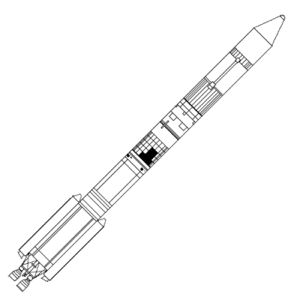
Home - Search - Browse - Alphabetic Index: 0- 1- 2- 3- 4- 5- 6- 7- 8- 9
A- B- C- D- E- F- G- H- I- J- K- L- M- N- O- P- Q- R- S- T- U- V- W- X- Y- Z
Titan 3BAS2
 Titan 3BAS Credit: © Mark Wade |
Status: Study 1965. Payload: 6,600 kg (14,500 lb). Thrust: 3,024.00 kN (679,822 lbf). Gross mass: 225,650 kg (497,470 lb). Height: 52.00 m (170.00 ft). Diameter: 3.05 m (10.00 ft). Apogee: 185 km (114 mi).
LEO Payload: 6,600 kg (14,500 lb) to a 185 km orbit. Payload: 1,900 kg (4,100 lb) to a GTO. Launch Price $: 14.000 million in 1965 dollars.
Stage Data - Titan 3BAS2
- Stage 0. 2 x Algol 2. Gross Mass: 11,600 kg (25,500 lb). Empty Mass: 1,650 kg (3,630 lb). Thrust (vac): 564.245 kN (126,847 lbf). Isp: 255 sec. Burn time: 47 sec. Isp(sl): 232 sec. Diameter: 1.01 m (3.31 ft). Span: 1.01 m (3.31 ft). Length: 9.09 m (29.82 ft). Propellants: Solid. No Engines: 1. Engine: Algol 2. Status: Out of Production.
- Stage 1. 1 x Titan 3B-1. Gross Mass: 139,935 kg (308,503 lb). Empty Mass: 7,000 kg (15,400 lb). Thrust (vac): 2,413.191 kN (542,507 lbf). Isp: 302 sec. Burn time: 161 sec. Isp(sl): 250 sec. Diameter: 3.05 m (10.00 ft). Span: 3.05 m (10.00 ft). Length: 23.99 m (78.70 ft). Propellants: N2O4/Aerozine-50. No Engines: 2. Engine: LR-87-11. Status: In Production.
- Stage 2. 1 x Titan 3B-2. Gross Mass: 37,560 kg (82,800 lb). Empty Mass: 2,900 kg (6,300 lb). Thrust (vac): 460.314 kN (103,483 lbf). Isp: 316 sec. Burn time: 230 sec. Isp(sl): 145 sec. Diameter: 3.05 m (10.00 ft). Span: 3.05 m (10.00 ft). Length: 8.60 m (28.20 ft). Propellants: N2O4/Aerozine-50. No Engines: 1. Engine: LR-91-11. Status: In Production.
- Stage 3. 1 x Centaur D/E. Gross Mass: 16,258 kg (35,842 lb). Empty Mass: 2,631 kg (5,800 lb). Thrust (vac): 131.222 kN (29,500 lbf). Isp: 444 sec. Burn time: 470 sec. Diameter: 3.05 m (10.00 ft). Span: 3.05 m (10.00 ft). Length: 9.60 m (31.40 ft). Propellants: Lox/LH2. No Engines: 2. Engine: RL-10A-3. Status: Out of Production.
- Stage 4. 1 x Burner 2. Gross Mass: 774 kg (1,706 lb). Empty Mass: 116 kg (255 lb). Thrust (vac): 43.551 kN (9,791 lbf). Isp: 285 sec. Burn time: 42 sec. Isp(sl): 220 sec. Diameter: 0.66 m (2.16 ft). Span: 0.66 m (2.16 ft). Length: 0.84 m (2.75 ft). Propellants: Solid. No Engines: 1. Engine: Star 37. Status: Out of Production. Burner II was a launch vehicle upper stage developed by Boeing for the Air Force Space Systems Division. It was the first solid-fuel upper stage with full control and guidance capability developed for general space applications. Burner II was designed for use with the Thor booster, but was readily adapted for use on the complete range of standard launch vehicles. Its general assignment was to place small- and medium size payloads into orbit. The Burner II motor, guidance system and reaction control system were integrated to provide attitude stability and precise control of flight rate and burnout velocity for orbital injection and earth-escape missions. Boeing had delivered 8 flight vehicles under its original contract. Under terms of a follow-on contract, it built 6 additional flight models. Four Thor-Burner II combinations were launched successfully from Vandenberg Air Force Base, California. The third launch placed 2 unclassified satellites in Earth orbit. A SECOR satellite, built for the U.S. Army Corps of Engineers by the Cubic Corporation, and an Aurora satellite, developed by Rice University for the Office of Naval Research, were placed in circular orbits 3,300 km above the Earth. As integration contractor for the Air Force Space Experiment Support Program (SESP) Office, Boeing designed, built and tested the injection stage, or "payload dispenser," which carried the 2 satellites on top of a standard Burner II stage and placed them in precise orbits. The satellites were mounted on opposite sides of the injection stage, which housed a640 kgf thrust, solid-propellant rocket motor. The Burner II was used as an upper stage by NASA for deep space probes. Prime Contractor: The Boeing Company. Major Subcontractors Thiokol Chemical Corporation (solid rocket motor); Honeywell Inc. (pre-programmed inertial guidance system); Walter Kidde Co. (reaction control system).
Family: orbital launch vehicle. Country: USA. Engines: RL-10A-3, LR87-11, LR91-11. Stages: Algol 2, Titan 3B-1, Titan 3B-2, Centaur D/E, Star 37. Agency: Martin.
1960 - . LV Family: Titan. Launch Vehicle: Titan 3BAS2.
- Titan 3B proposed for deep space missions with Centaur upper stage. - . Nation: USA. Configuration of Titan 3B proposed by Martin in mid-1960's. Titan 3B for deep space missions with Centaur upper stage, Algol strapons for liftoff thrust augmentation. Never flown..
Back to top of page
Home - Search - Browse - Alphabetic Index: 0- 1- 2- 3- 4- 5- 6- 7- 8- 9
A- B- C- D- E- F- G- H- I- J- K- L- M- N- O- P- Q- R- S- T- U- V- W- X- Y- Z
© 1997-2019 Mark Wade - Contact
© / Conditions for Use